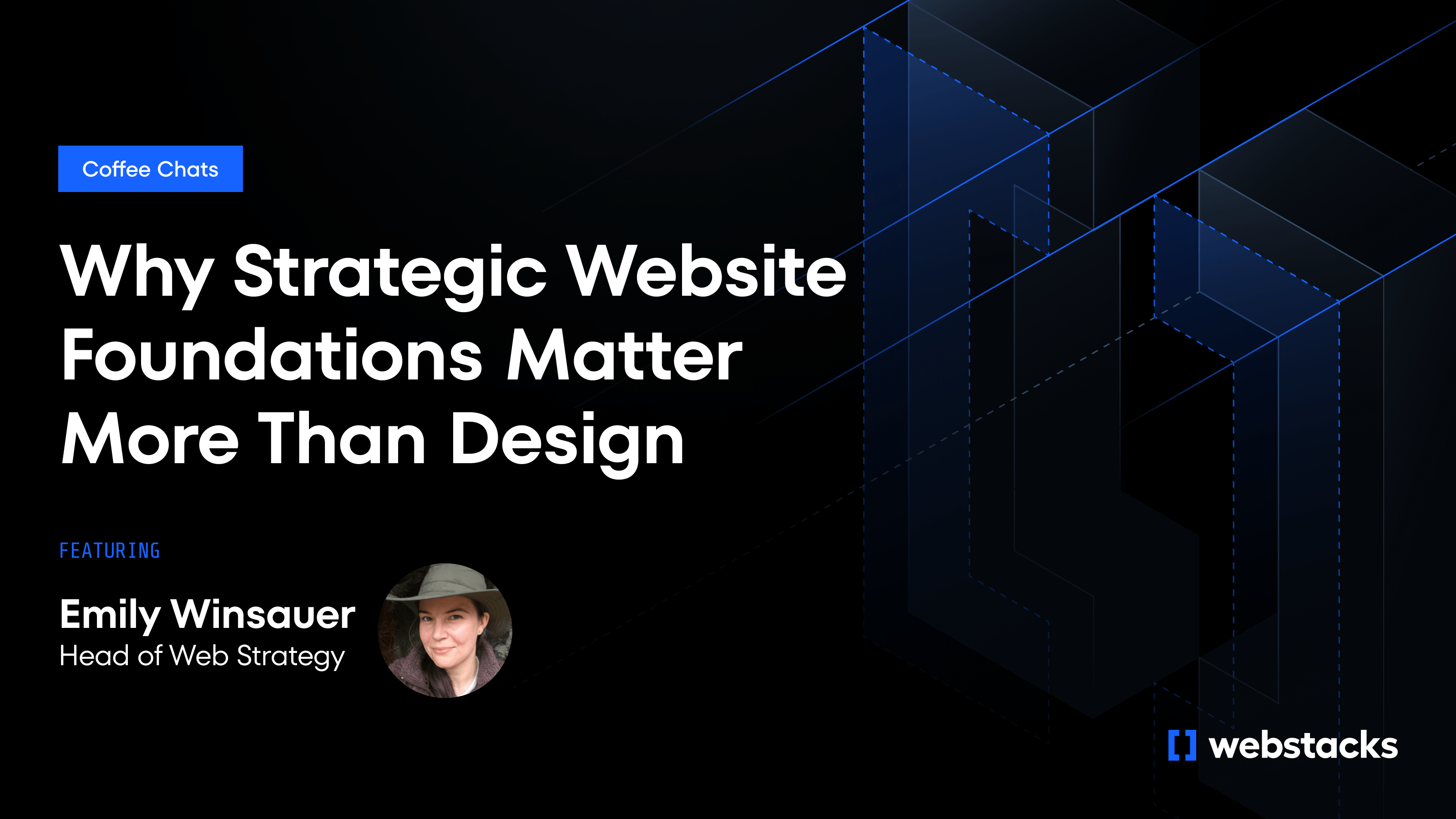Enterprise website redesigns are high-stakes projects that can make or break years of digital marketing investment. When executed properly, they accelerate business growth and unlock new marketing capabilities. When they fail, the consequences ripple through organizations for months or even years.
The statistics tell a sobering story: most enterprise redesigns experience significant traffic drops, with recovery times extending well beyond initial projections. The culprits are predictable yet preventable—missing 301 redirects that destroy SEO equity, governance chaos that creates approval bottlenecks, performance regressions that hurt conversion rates, and inflexible architectures that constrain marketing velocity long after launch.
But here's what separates successful redesigns from costly failures: treating these risks as core requirements rather than afterthoughts. The difference lies in having a comprehensive strategic framework that protects existing digital assets while building infrastructure for future growth.
This guide provides that framework—a proven approach that transforms enterprise website redesigns from risky necessary evils into strategic competitive advantages.

Phase 1: Strategic Discovery and Risk Assessment
Every successful enterprise redesign begins with comprehensive discovery that transforms unknowns into manageable project requirements. This phase establishes clear success criteria and identifies potential failure points before any development begins.
Complete Digital Asset Inventory
Start with a thorough crawl using Screaming Frog or similar tools to capture every URL, image, and schema object across your entire digital ecosystem. This comprehensive inventory becomes the foundation for all downstream decisions about redirects, content migration, and architecture planning. Pay special attention to:
- Main domain and all subdomains
- Legacy microsites and campaign landing pages
- Asset repositories and download centers
- Archived content that still receives traffic
Export 12 months of analytics data covering sessions, conversions, and revenue per page. These baseline metrics become your success criteria and help you prioritize which pages deserve the most attention during redesign.
Project Classification and Impact Analysis
Define your project type precisely, as each carries different risk levels and requirements. Understanding your specific redesign category allows you to allocate resources appropriately and implement the right safeguards from the beginning.
The three primary categories include:
- Domain migrations pose the highest SEO risk and require the most comprehensive redirect planning
- CMS replacements typically carry moderate risk when properly executed
- URL restructuring requires careful internal linking and redirect management
Document current governance pain points including shadow administrators, undefined approval workflows, and role conflicts. These issues compound during transitions, so addressing them upfront prevents project delays and cost overruns.
Success Metrics and Risk Mitigation
Establish clear KPIs tied to business outcomes. These metrics serve as both success criteria and early warning indicators if the redesign veers off course. Focus on measurable targets that align with your organization's priorities:
- Organic traffic retention targets (typically 95%+ within 30 days)
- Core Web Vitals performance benchmarks
- Conversion rate maintenance thresholds
- Time-to-market improvements for marketing campaigns
Create contingency plans for common failure scenarios, including rollback procedures and stakeholder communication protocols.
Phase 2: Technology Architecture and Platform Selection
The technology choices made during redesign determine your marketing team's velocity for years to come. Legacy monolithic systems create bottlenecks where every page change requires developer intervention, while modern headless architecture enables marketing teams to execute campaigns independently.
Headless Architecture for Marketing Independence
Modern enterprise redesign strategy centers on headless architecture that separates content management from presentation. This approach eliminates the bottlenecks that plague traditional monolithic systems, where marketing teams must wait for developers to implement even simple changes.
Headless platforms like Contentful or Storyblok paired with React frameworks like Next.js deliver:
- Marketing team independence from development cycles
- Rapid iteration capabilities for campaign execution
- Future-proof scaling where new channels integrate without rebuilding core systems
- Superior performance through optimized rendering and caching
When Curative pivoted from COVID testing to employer health insurance, their headless architecture enabled them to serve multiple audiences—insurance brokers, employers, healthcare providers, and plan members—without requiring separate platforms or extensive development resources.
Component-Driven Development Strategy
Build a comprehensive library of reusable components that non-technical editors can configure and deploy. This component library becomes your marketing team's toolkit for rapid campaign execution without requiring custom development for each initiative.
Essential components include:
- Hero sections with variable layouts and CTAs
- Testimonial blocks with rich media support
- Resource cards for content marketing
- Form builders for lead generation
- Interactive elements for engagement
This component approach accelerates time-to-market while maintaining design consistency and reducing development dependencies.
Performance and Governance Integration
Bake performance targets into the build process rather than treating them as post-launch optimizations. Modern search algorithms prioritize user experience signals, making performance a competitive differentiator rather than just a technical requirement.
Target these specific benchmarks:
- Largest Contentful Paint under 2.5 seconds
- Lighthouse scores above 90 on mobile devices
- Cumulative Layout Shift below 0.1
- First Input Delay under 100 milliseconds
Implement role-based access controls that match your organizational structure while enabling workflow efficiency. Marketing managers need page creation rights, content editors require approval workflows for sensitive pages, and legal teams need visibility without creating bottlenecks.
Phase 3: SEO Equity Protection and Content Strategy
SEO equity represents years of content investment and organic ranking authority that can vanish overnight without systematic protection. Enterprise sites typically have thousands of pages and complex internal linking structures that require meticulous preservation planning.
Comprehensive URL Mapping and Redirect Strategy
Map every existing URL to its future destination, keeping URL paths identical wherever practical. This upfront work prevents the traffic disasters that catch most teams off guard when search engines encounter broken links and missing pages.
Execute these essential mapping steps:
- Export the complete URL inventory from your site crawl
- Create 1:1 mappings for equivalent content
- Identify consolidation opportunities for thin or duplicate content
- Plan redirect chains carefully to avoid authority dilution
Load your redirect mapping into staging environments and test thoroughly to eliminate redirect loops and chains before they impact live traffic.
Technical SEO Preservation
Preserve and enhance critical SEO elements during migration rather than treating them as afterthoughts. These technical signals represent years of optimization work and search engine trust that can't be rebuilt quickly if lost during the transition.
Focus on maintaining:
- Title tags and meta descriptions: Maintain proven performers while optimizing underperformers
- Header structure: Preserve H1-H6 hierarchy while improving accessibility
- Internal linking: Maintain authority flow while adding strategic cross-links
- Structured data: Update schema markup to reflect new architecture
Update supporting technical elements:
- Robots.txt configuration for proper crawling permissions
- XML sitemaps reflecting new site structure and priority pages
- Canonical tags preventing duplicate content issues across domains
- Image alt text and file naming conventions for accessibility and SEO
Content Strategy and Information Architecture
Design your new information architecture to support both current content and future growth without requiring structural changes. A well-planned architecture prevents the content sprawl and navigation confusion that often emerge as organizations scale their digital presence.
Key considerations include:
- Create logical content categories that align with user journeys
- Establish clear content hierarchies that distribute authority effectively
- Plan for content scaling without structural changes
- Design navigation that supports both human users and search engine crawlers
Curative's content restructuring enabled them to serve dramatically different audiences without compromising user experience, contributing to their nearly 100% year-over-year traffic growth post-redesign.

Phase 4: Launch Execution and Quality Assurance
Launch day separates well-planned redesigns from reactive scrambles. Despite thorough preparation, enterprise launches always surface unexpected issues. Success comes from having monitoring systems and response protocols that turn potential disasters into manageable incidents.
Strategic Launch Planning
Execute cutover during your lowest traffic window to minimize revenue impact, typically late night or early morning in your primary market. Successful launches require coordinating multiple technical changes simultaneously to avoid the cascading failures that occur when systems update at different times.
Coordinate these technical changes simultaneously:
- DNS updates and SSL certificate changes
- CDN configuration and cache clearing
- Database migrations and content imports
- Third-party integrations and API connections
Have your core team available for immediate response, with clear escalation paths for different types of issues.
Real-Time Quality Assurance
The moment your new site goes live, execute comprehensive validation to catch issues before they impact users or search engine crawlers. The first few hours post-launch are critical for identifying and resolving problems that inevitably surface despite thorough testing in staging environments.
Priority validation tasks include:
- Run complete site crawl comparing URLs against redirect mapping
- Test critical revenue paths including checkout flows and lead generation forms
- Verify all third-party integrations including analytics, CRMs, and marketing automation
- Confirm mobile responsiveness and cross-browser compatibility
Address any 404 errors, redirect loops, or broken functionality immediately—these issues compound rapidly once users and search engines encounter them.
Monitoring and Response Framework
Implement real-time alerts for critical metrics that indicate potential problems requiring immediate attention. Early detection enables rapid response before small issues escalate into major traffic or revenue losses. Monitor these key indicators:
- 404 error rate spikes indicating redirect failures
- Server errors (5xx responses) suggesting configuration issues
- Core Web Vitals degradation affecting search rankings
- Conversion rate drops signaling funnel problems
Prepare response playbooks for common scenarios:
- Redirect failures: Server configuration updates and cache clearing
- Performance issues: Database optimization and third-party script audits
- Functionality breaks: Rollback procedures and hot fixes
- SEO concerns: Search Console monitoring and index status tracking
Phase 5: Long-Term Optimization and Growth Acceleration
The real value of enterprise redesign strategy emerges in the months following launch. While immediate technical success matters, long-term ROI depends on how well your new platform enables marketing velocity, conversion optimization, and sustained business growth.
Performance Review and Optimization Cycles
Schedule formal assessments at strategic intervals to validate your redesign's impact and identify optimization opportunities. These structured reviews prevent issues from compounding while ensuring your new platform delivers the promised business benefits.
Conduct formal reviews at these critical intervals:
- 7-day review: Focus on technical stability, critical path functionality, and immediate issue resolution
- 30-day review: Examine organic traffic trends, conversion performance, and Core Web Vitals stability
- 90-day review: Analyze marketing velocity improvements, content creation efficiency, and ROI metrics
Use these reviews to identify optimization opportunities and validate your redesign's impact on business objectives.
Marketing Velocity and Capability Enhancement
Track how your new platform improves marketing team performance compared to your legacy system. These velocity improvements represent the long-term ROI of your redesign investment and justify the upfront costs through sustained operational efficiencies.
Key performance indicators include:
- Time-to-market for new campaigns and landing pages
- A/B testing capabilities and conversion optimization
- Content creation and publishing efficiency
- Multi-channel campaign coordination and tracking
The infrastructure you've built should demonstrably accelerate these activities compared to your legacy platform.
Continuous Improvement Framework
Establish ongoing optimization processes that ensure your redesign continues delivering value long after launch. Without systematic improvement cycles, even the best platforms gradually become outdated and lose their competitive advantages.
Implement these ongoing review cycles:
- Monthly performance audits identifying improvement opportunities
- Quarterly content strategy reviews ensuring alignment with business goals
- Semi-annual technology assessments planning for future capabilities
- Annual strategic reviews validating platform ROI and planning next phases
From Risk to Strategic Advantage
Enterprise website redesigns don't have to be risky gambles with uncertain outcomes. When approached strategically, they become transformational investments that accelerate business growth for years to come. The framework outlined here—from comprehensive discovery through long-term optimization—provides the structure needed to protect existing digital assets while building capabilities for future success.
Success stories like Curative's transformation demonstrate what's possible when redesigns are executed strategically. Their nearly 100% traffic growth and enhanced marketing capabilities resulted from careful planning, modern architecture choices, and disciplined execution that treated common failure points as core requirements rather than afterthoughts.
Organizations looking to achieve similar results need partners who understand both the technical complexities and business implications of enterprise redesigns. Connect with our experts to explore how this strategic approach could transform your organization's digital capabilities.




